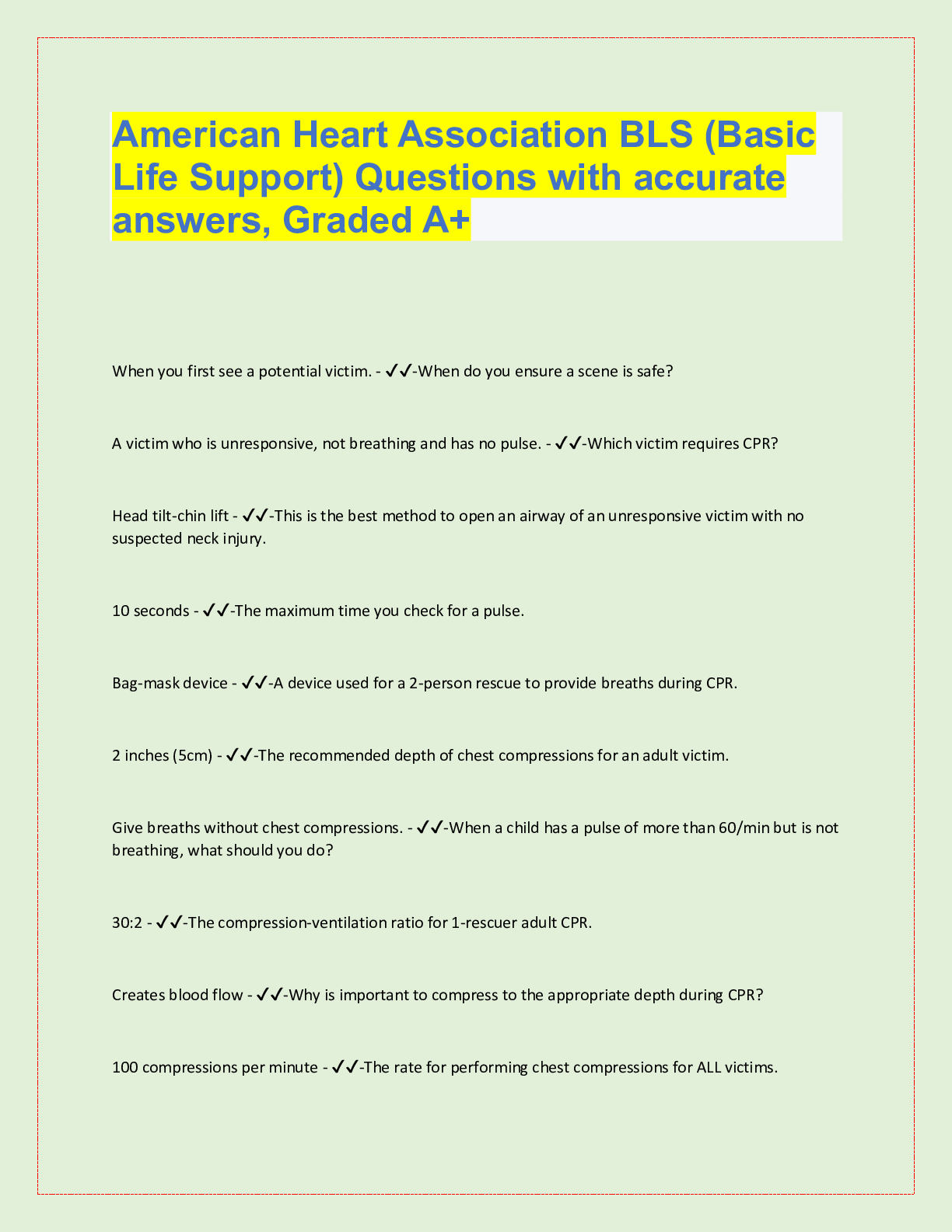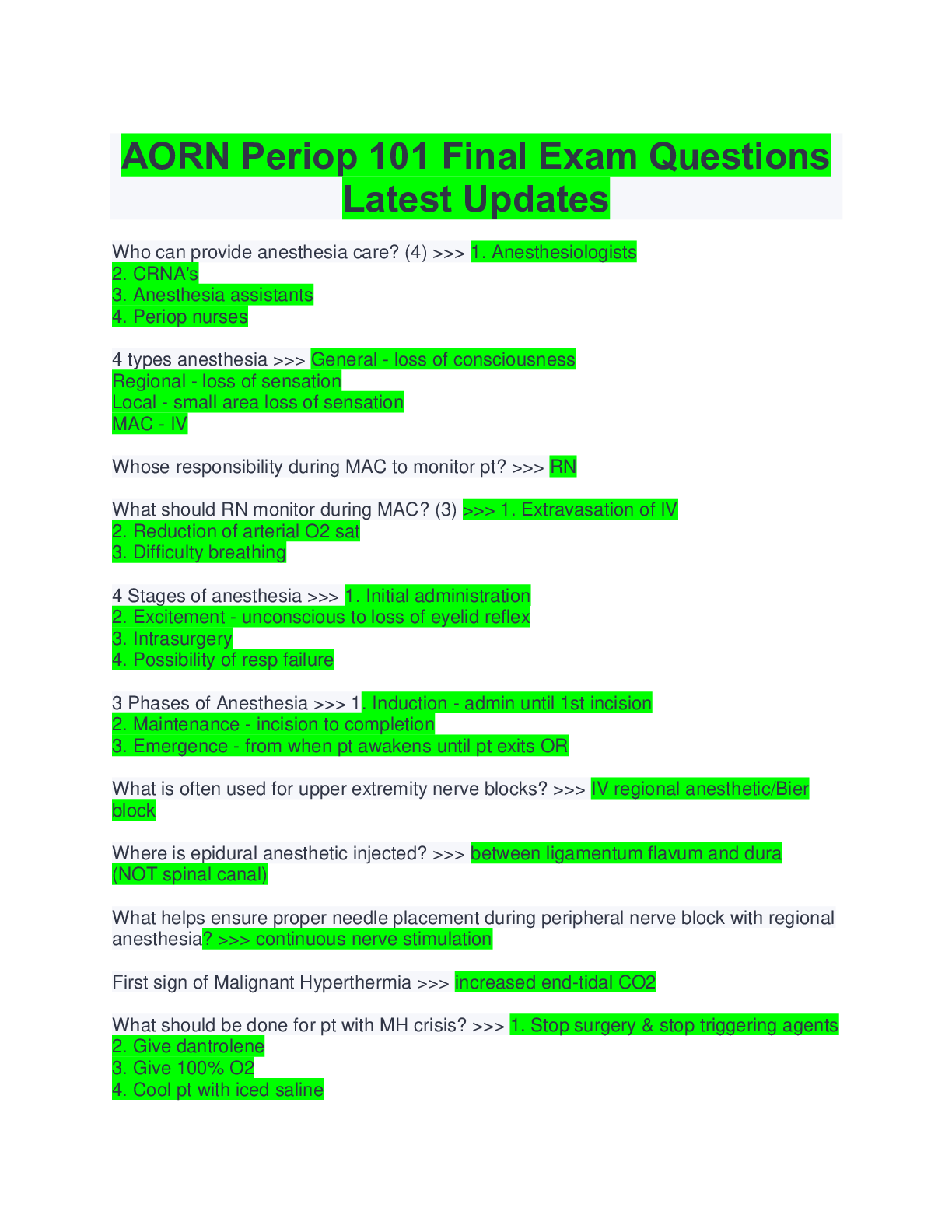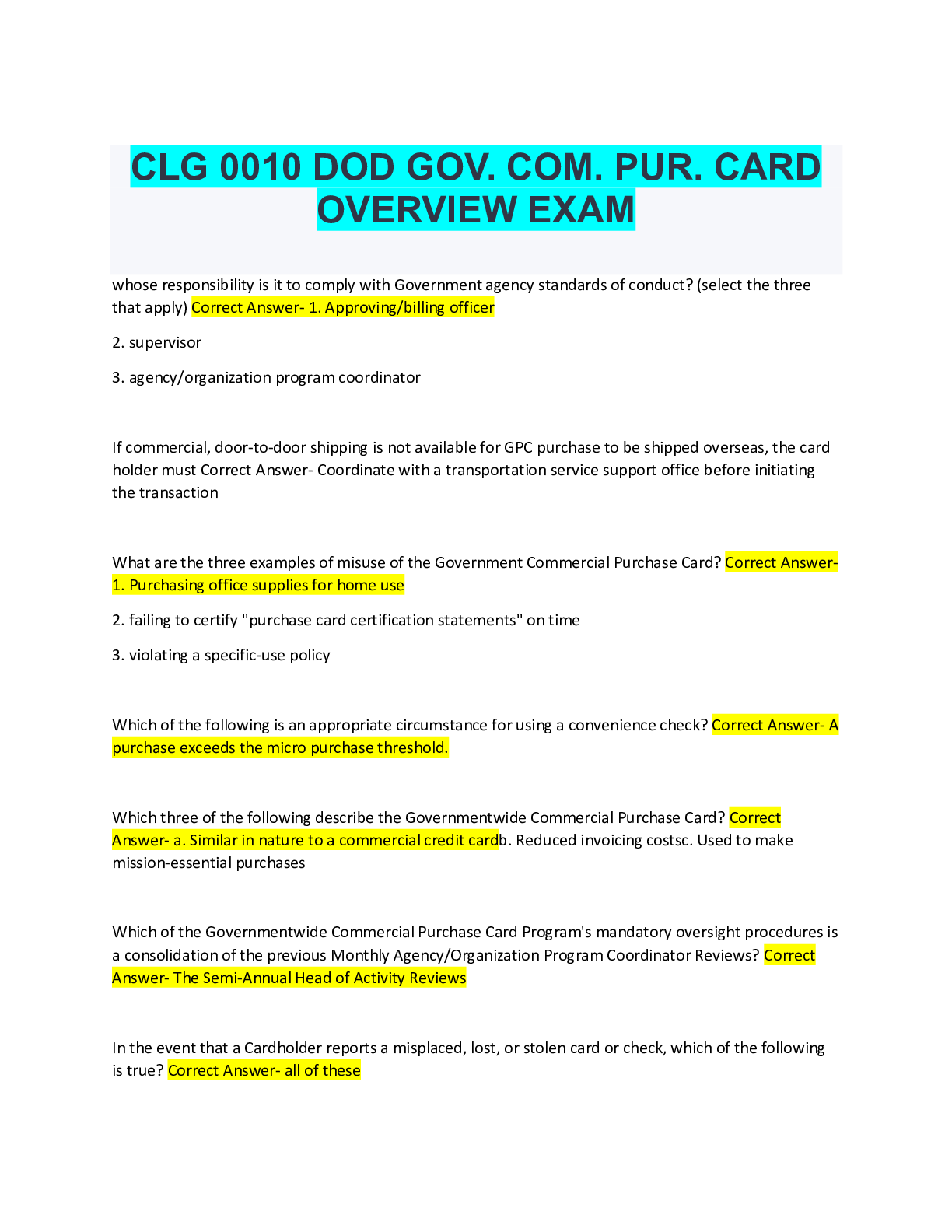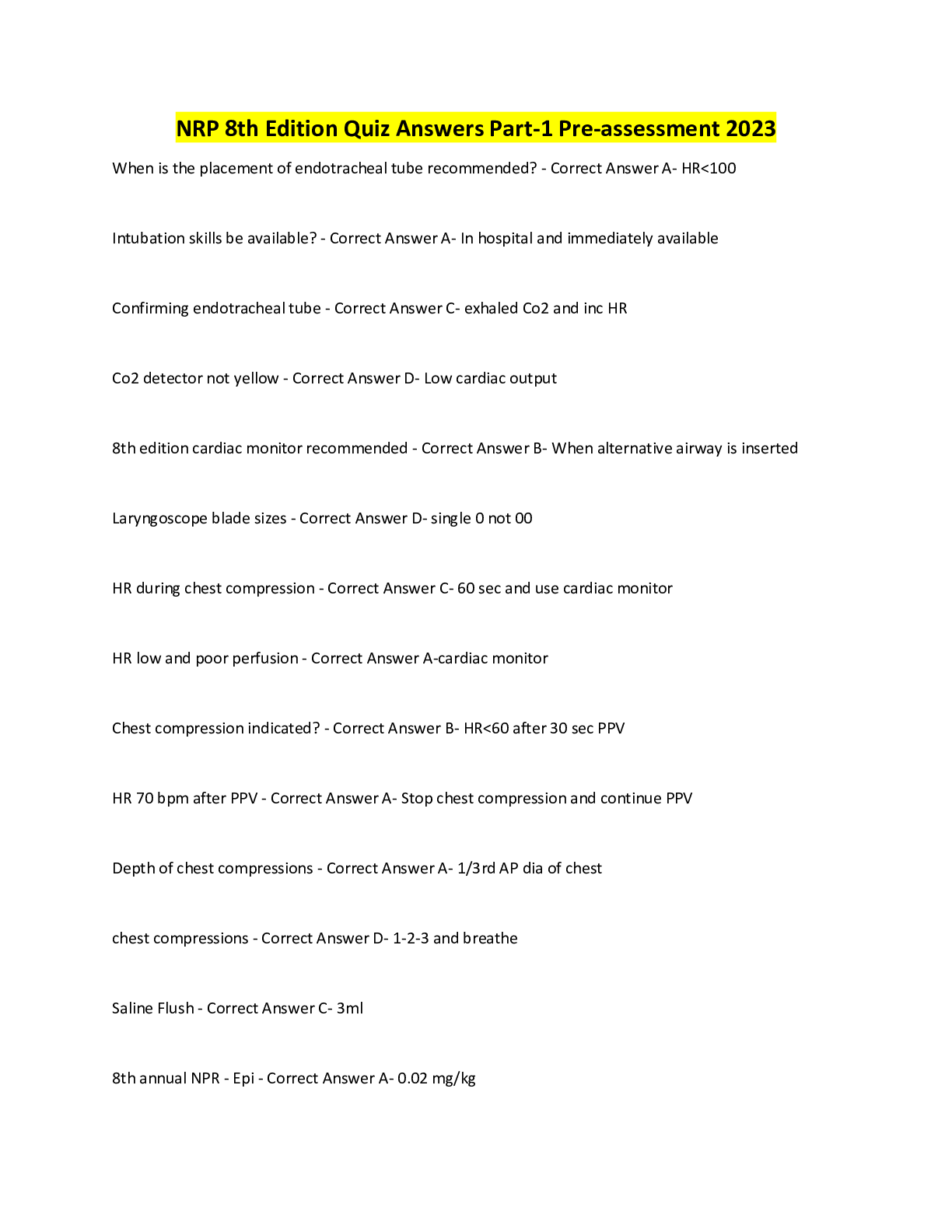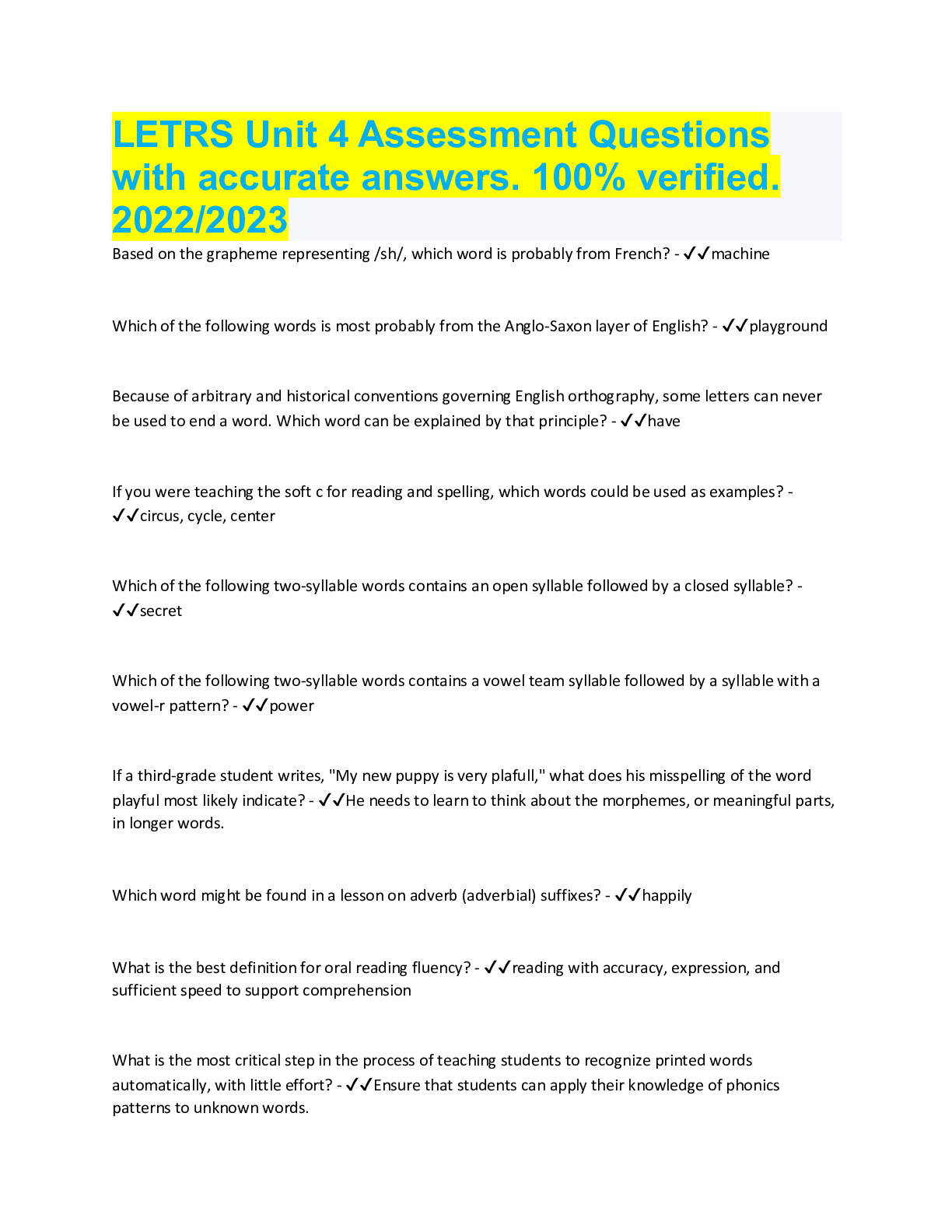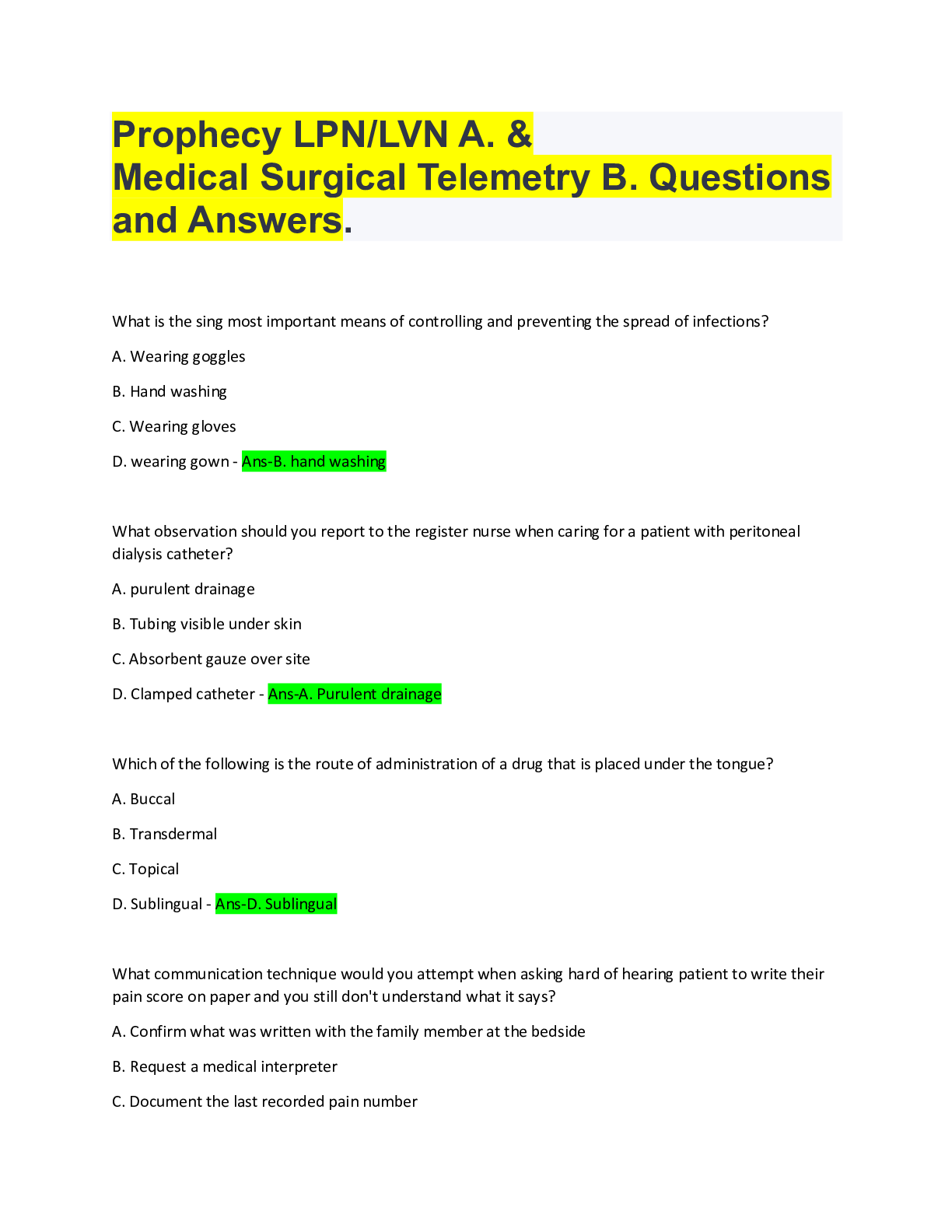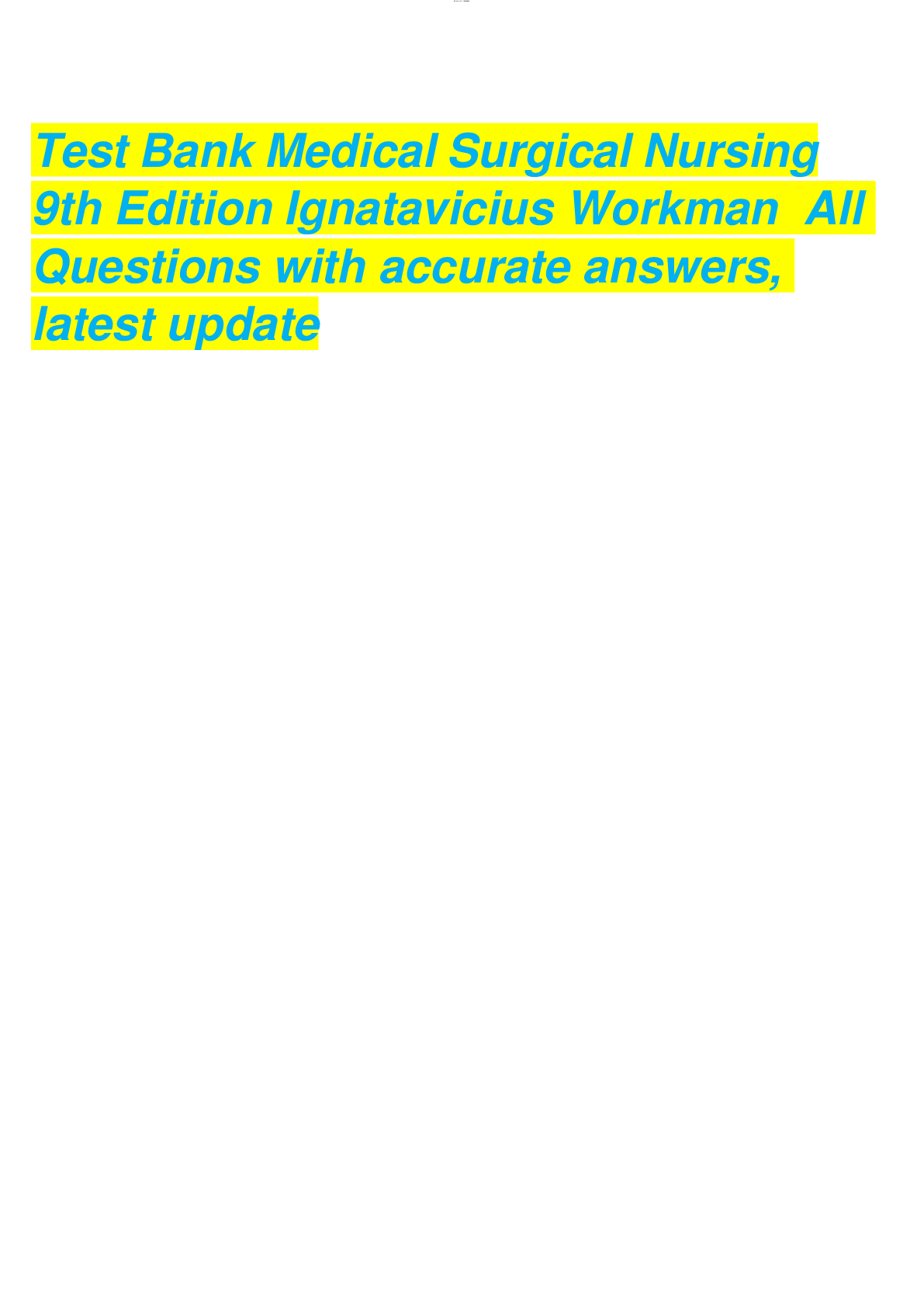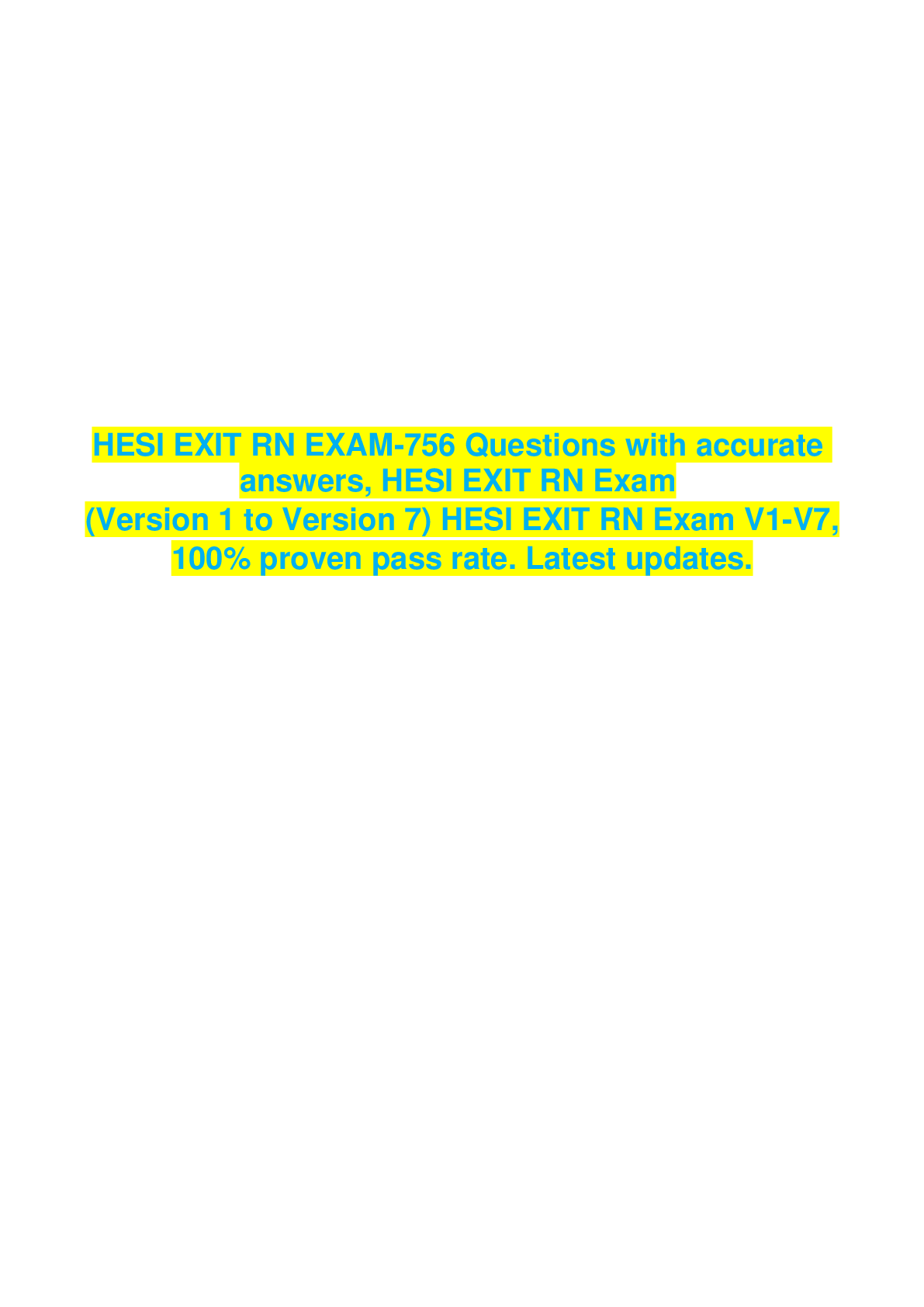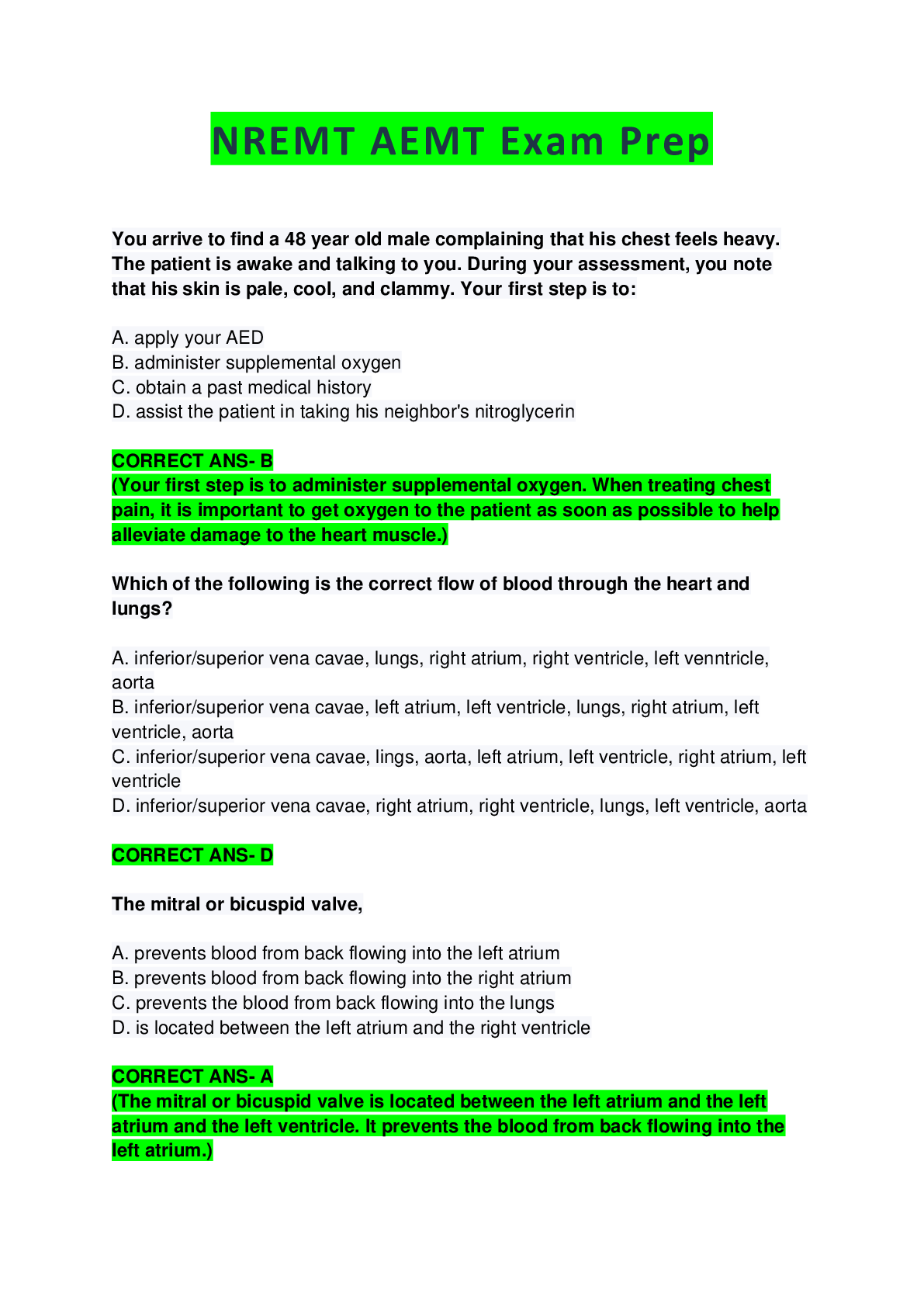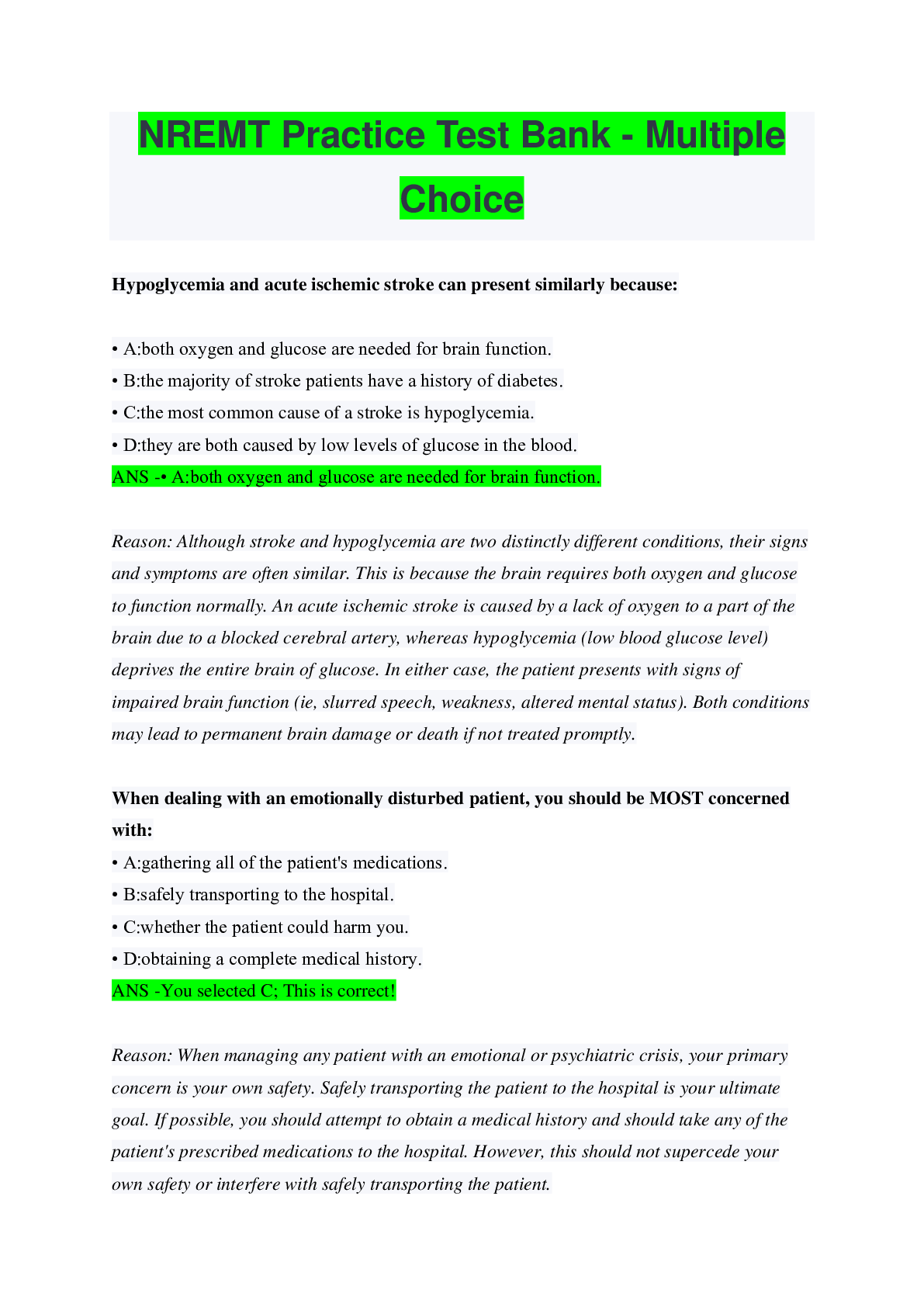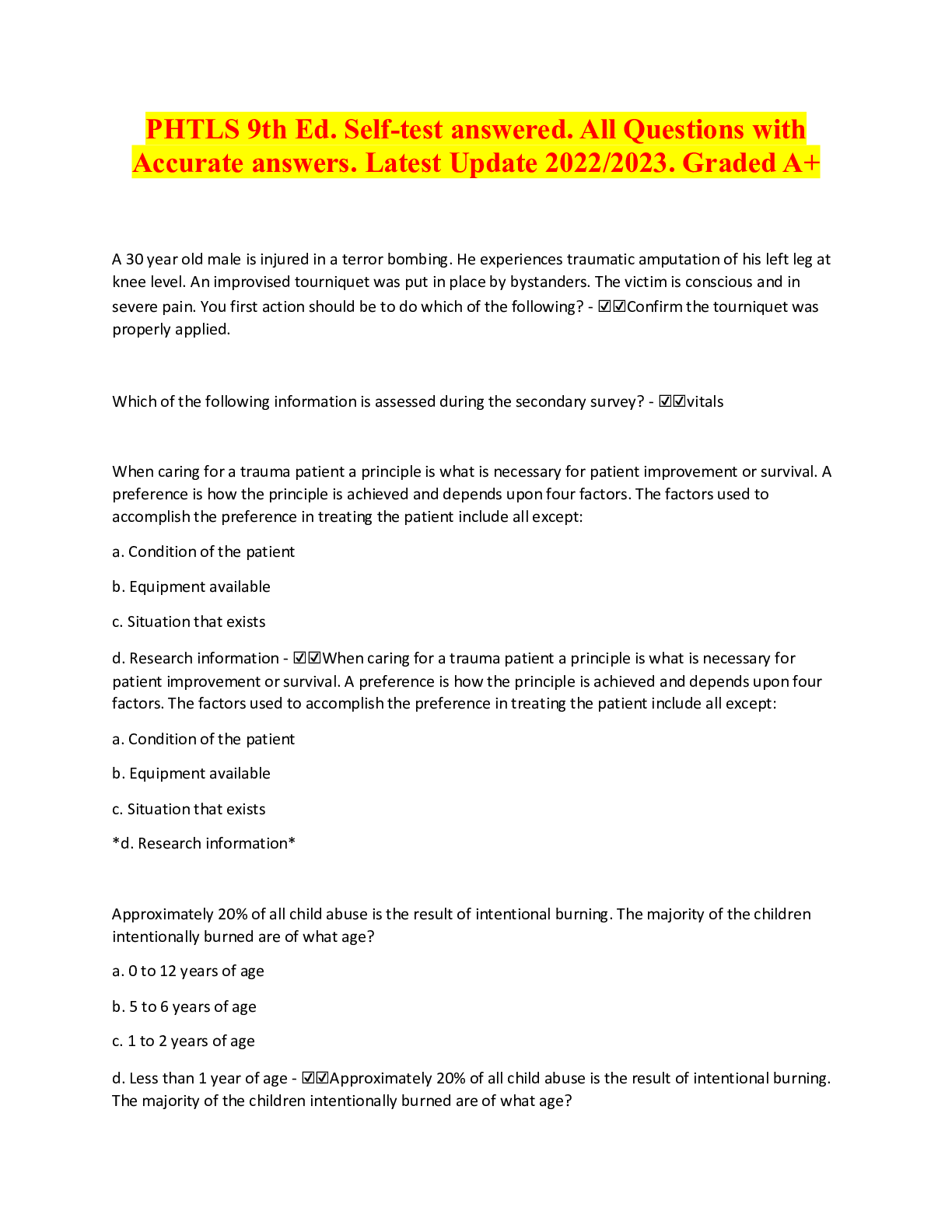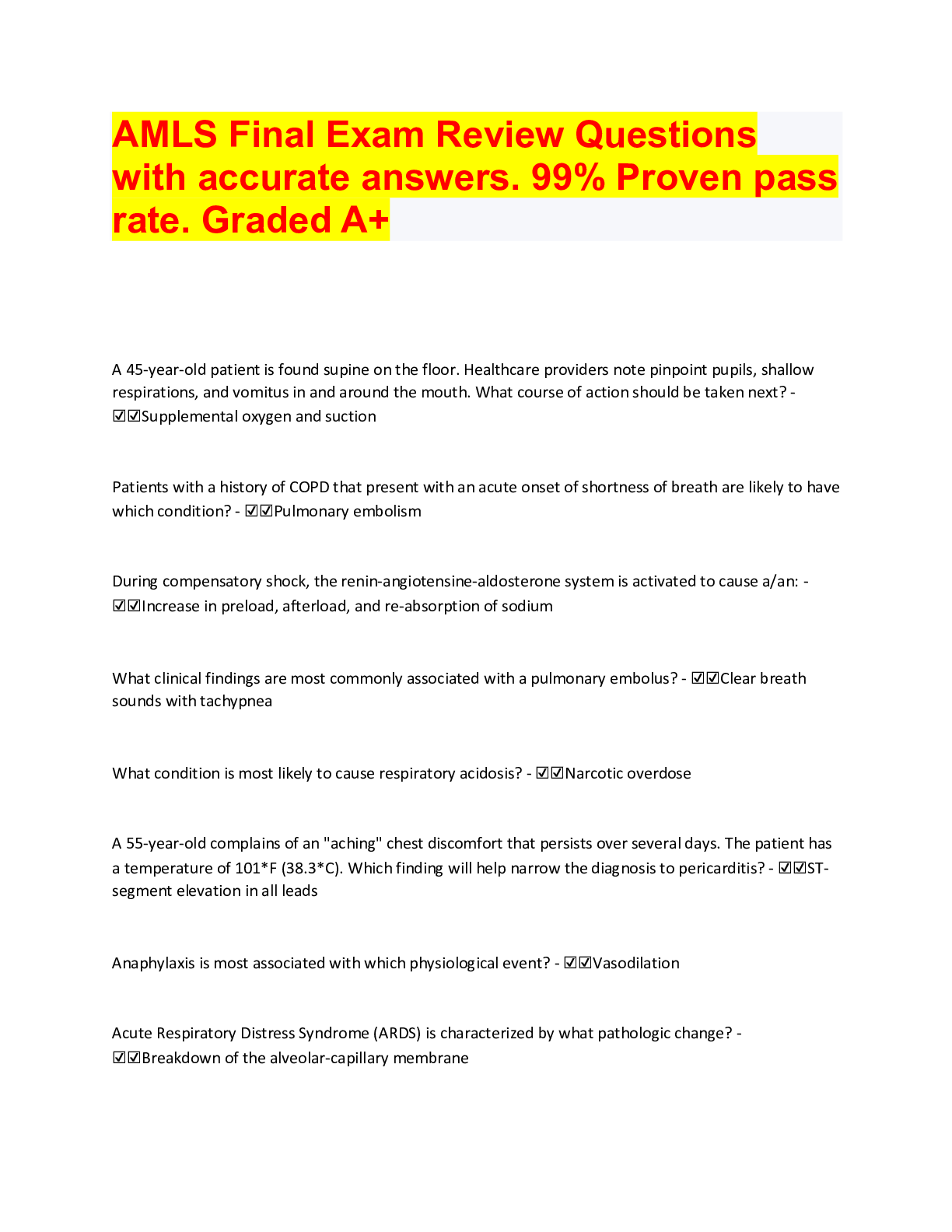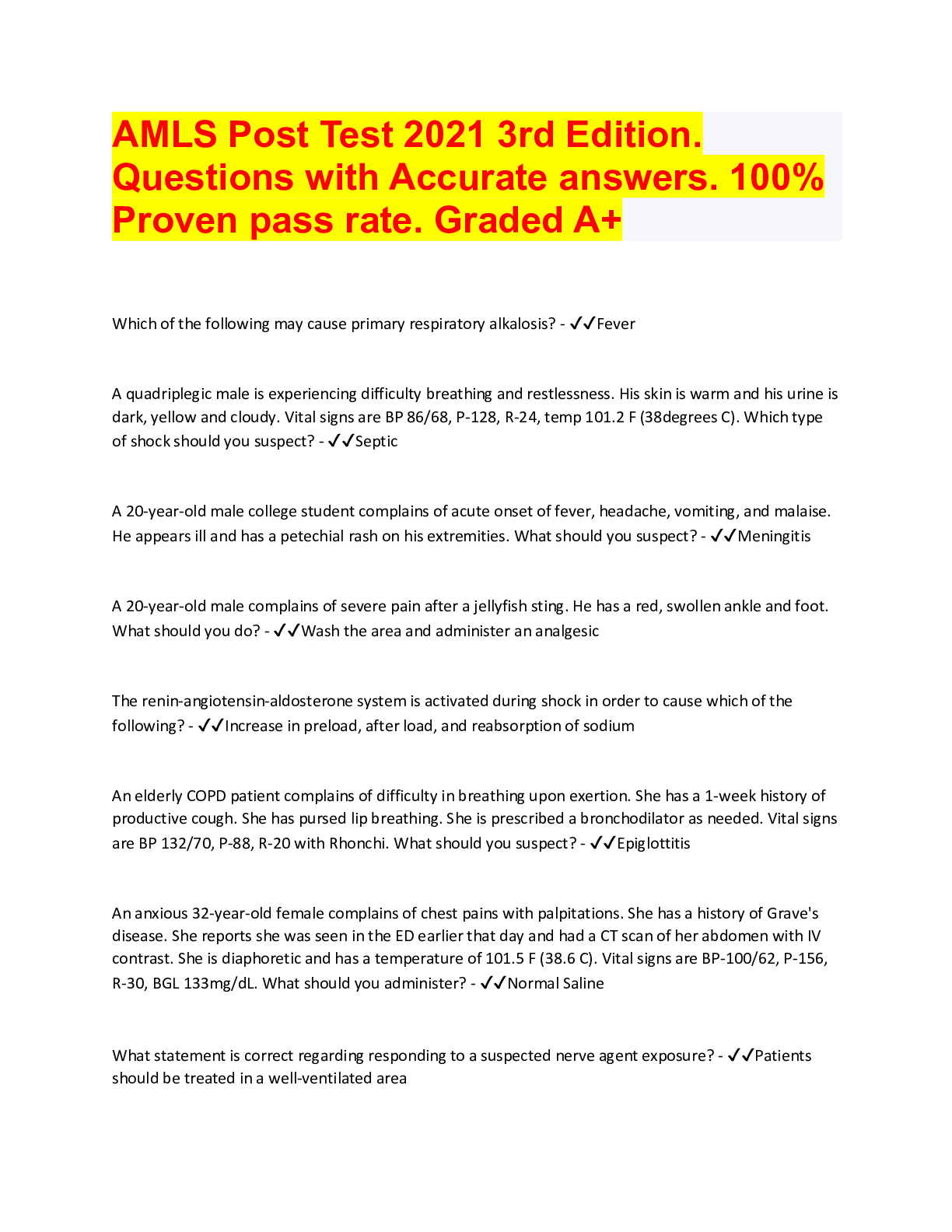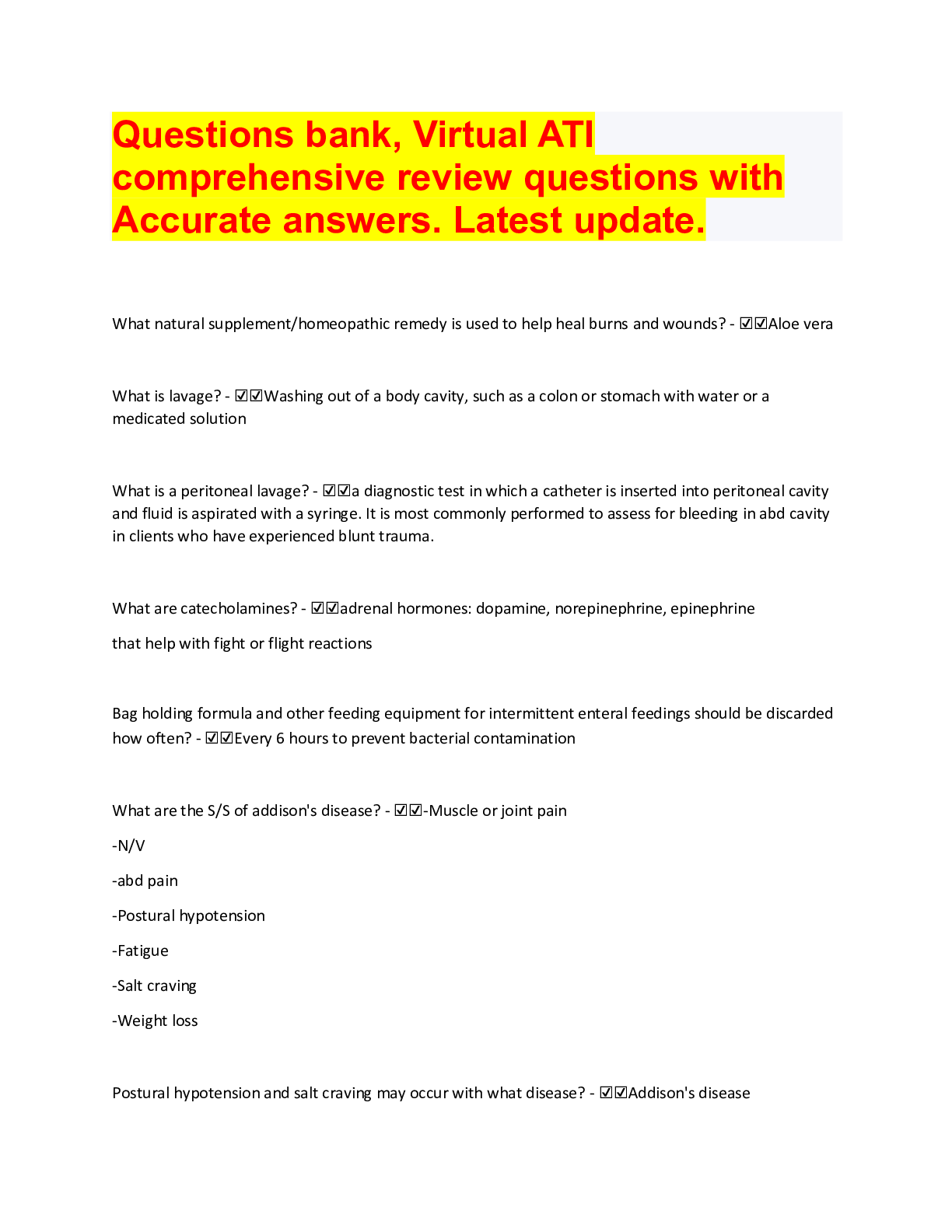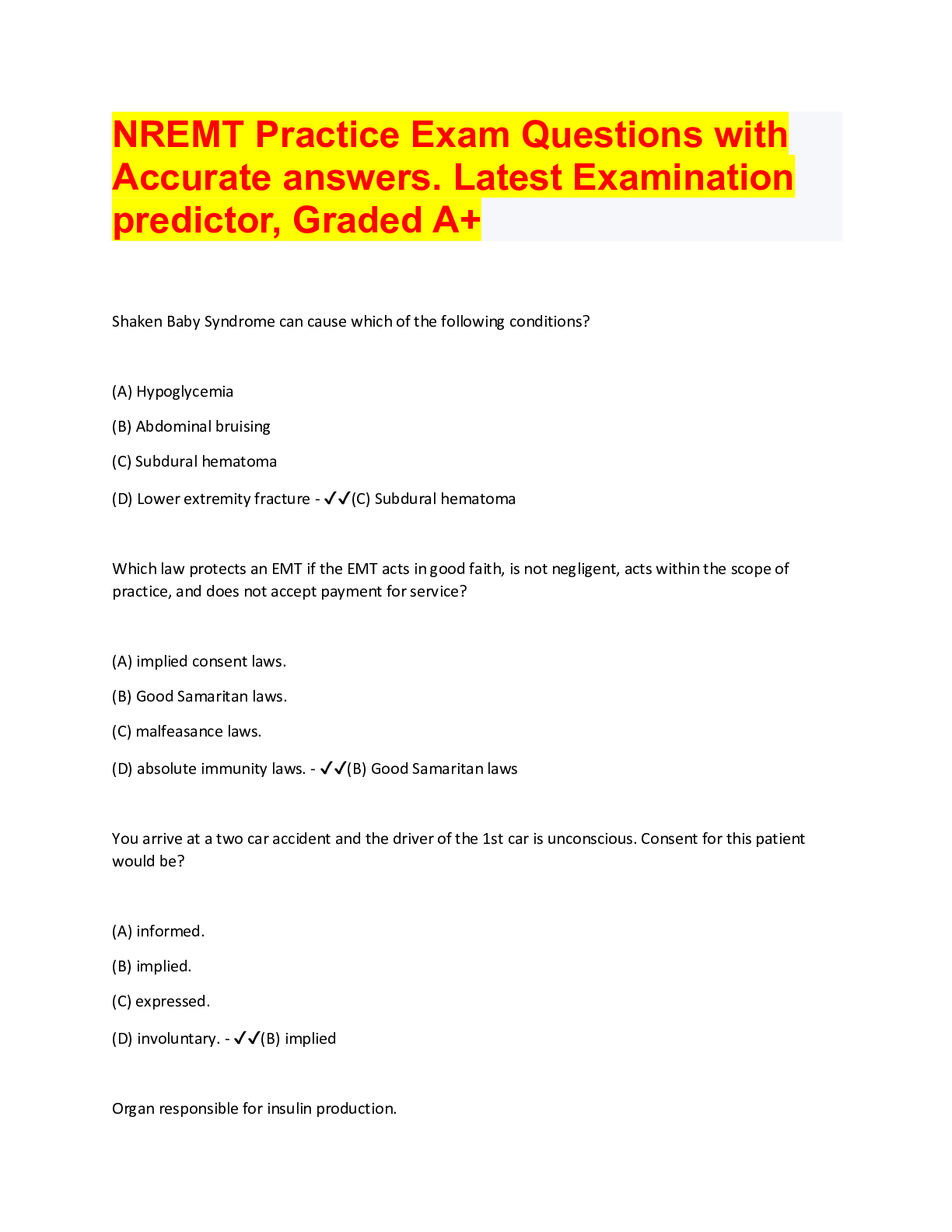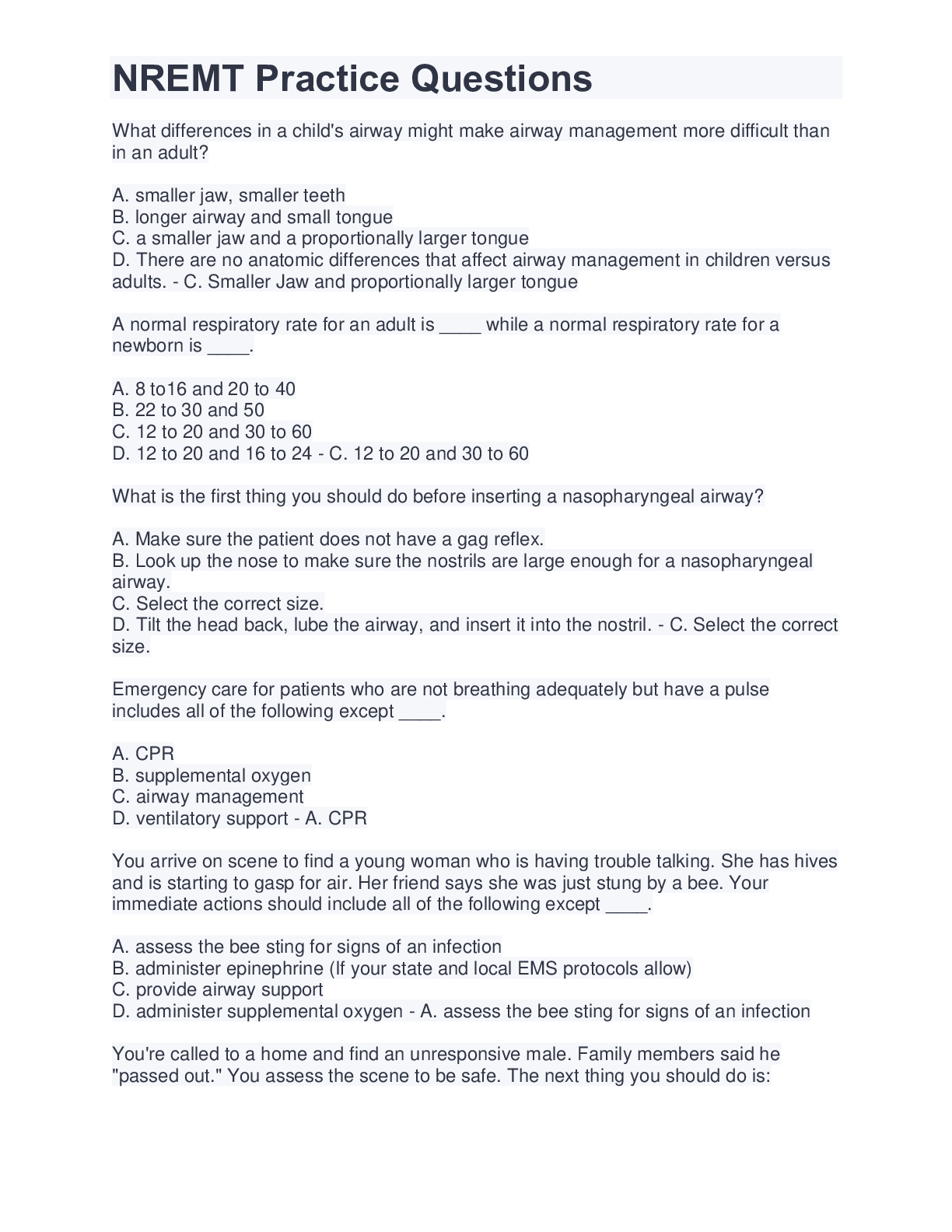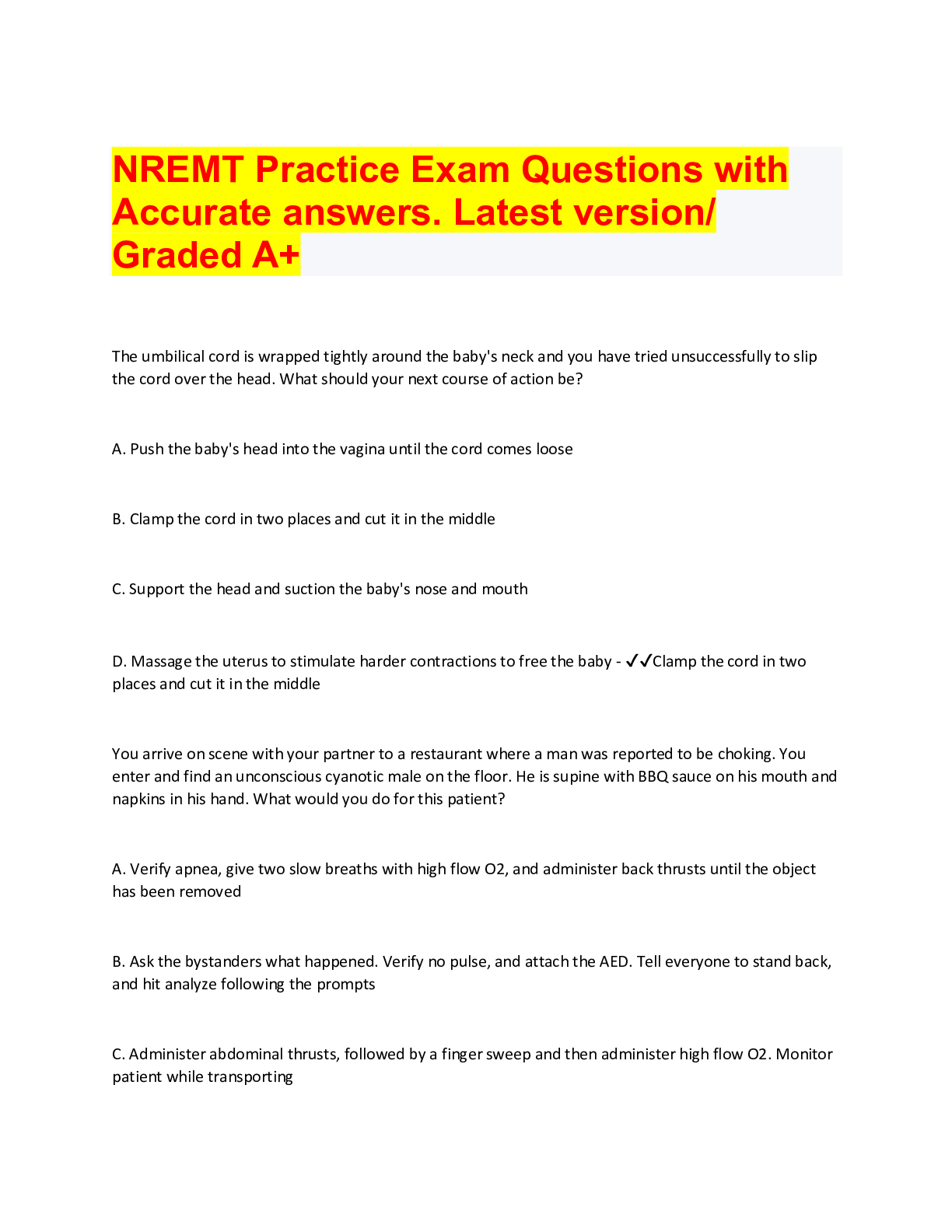*NURSING > QUESTIONS & ANSWERS > NREMT EMT-B Word Bank 2022. Questions with accurate answers. 99% proven pass rate. (All)
NREMT EMT-B Word Bank 2022. Questions with accurate answers. 99% proven pass rate.
Document Content and Description Below
A 13-year-old male presents with left arm pain after a fall. You observe swelling and a deformity to his left lower arm. You are unable to palpate a pulse distal to the injury. You should first A. pl... ace his arm in a sling and swathe. B. splint his arm in the anatomical position. C. splint his arm in the position found. D. place him on a long backboard. - ✔✔B, splint his arm in the anatomical position. A 48-year-old male presents with a laceration to his abdomen. You observe bowel protruding from the wound. You should first A. apply a moist, sterile dressing. B. place the bowel back into his abdomen. C. apply a dry, sterile dressing. D. place the exposed bowel on ice. - ✔✔A, apply a moist, sterile dressing. A 59-year-old female is unresponsive, pulseless, and apneic. You should first A. begin chest compressions. B. ventilate her with a BVM. C. retrieve the AED. D. perform abdominal thrusts. - ✔✔A, begin chest compressions 24-year-old patient fell while skateboarding and has a painful, swollen, deformed lower arm. An EMT is unable to palpate a radial pulse. What should the EMT do next? A. Apply cold packs to the injury B. Align the arm with gentle traction C. Splint the arm in the position found. D. Ask the patient to try moving their arm - ✔✔B, align the arm with gentle traction An 86-year-old patient with terminal brain cancer is disoriented after a fall. The patient reports severe right hip pain. The spouse tells the EMT that the patient has DNR orders and does not want the patient transported. What should the EMT do next? A. Explain the risks of refusal of transport. B. Ask to see the patient's DNR orders. C. Have the patient sign a refusal form. D. Request law enforcement intervention. - ✔✔A, explain the risks of refusal of transport. Law enforcement officers have detained a patient who they believe is drunk. The officers called because the patient has a history of diabetes. An EMT administers oral glucose, and within a minute, the patient becomes unresponsive. What should an EMT do first? A. Perform chest compressions. B. Initiate rapid transport. C.Begin positive pressure ventilations. D. Suction the patient's airway. - ✔✔D, suction the patient's airway You are assessing an 84 year old man. Upon auscultation of the lungs you discover crackles or rales sounds. He is complaining of chest pain and congestion. These signs and symptoms can indicate? A. An embolism B. Collapse of vena cava C. Right ventricular failure D. Left ventricular failure - ✔✔D, left ventricular failure Of the following, which body fluid has the most potential to transmit blood-borne diseases? A. Nasal discharge B. Vomit C. Amniotic fluid D. Feces - ✔✔C, amniotic fluid A 70-year-old patient who has a history of emphysema is complaining of shortness of breath. What should you do? A. Administer oxygen, because in most cases, the hypoxic drive will not be a problem. B. Withhold oxygen, since these patients do not respond to oxygen. C. Withhold oxygen, because you could eliminate the hypoxic drive. D. Withhold oxygen, because these patients become apneic if they receive high-flow oxygen. - ✔✔A, Administer oxygen, because in most cases, the hypoxic drive will not be a problem. A 32-year-old male was complaining of a severe, crushing feeling in the center of his chest and shortness of breath that began while he was mowing his lawn 45 minutes before you arrived. He is now only responding to painful stimuli. His minute ventilation is still adequate, his pulse oximeter reads 95% on room air, and you find his skin to be pale, cool, and diaphoretic. What should you do first? A. 325 mg aspirin B. 12-15 LPM NRB C. Nitro D. 4-6 LPM cannula - ✔✔B, 12-15 LPM NRB You are transporting a patient who is having night sweats, mild fever, and a productive cough. He states that the health department has been treating him at home for a respiratory condition. The patient should be transported to the hospital ________. A. In the left lateral recumbent position B. In a calm manner C. In a position of comfort D. With a mask on the patient and the EMT - ✔✔D, With a mask on the patient and the EMT When a rigid suction catheter is used with infants and young children, what can stimulating the back of the throat do? A. Be ineffective in suctioning. B. Lead to immediate vomiting. C. Cause the tongue to fall into the airway. D. Cause changes in the heart rhythm. - ✔✔D, cause changes in the heart rhythm You intubate the patient en route to the hospital. You hear wheezing in the upper lung fields during your assessment of tube placement. What is the probable cause of this wheezing? A. Inhalation injury to the lower airway B. Inhalation injury to the upper airway C. Inhalation induced cardiac wheezing D. Inhalation induced asthma attack - ✔✔A, Inhalation injury to the lower airway (An inhalation injury inferior to the glottis can cause wheezing and bronchospasm. A hoarse voice and stridor can be caused by an inhalation injury superior to the glottis. Inhalation of the byproducts of combustion can result in wheezing but this would still be classified as an inhalation injury to the lower airway.) You must transfer care to the ED staff when you arrive at the receiving facility. What you have just allowed for by giving a report to the attending nursing staff about the past medical history, the patient's complaint assessment, and interventions? A. Continuity of care B. Quantum of care C. Prime Directive D. Quality transfer of care - ✔✔A, continuity of care Your patient is not responding to your loud verbal stimuli. You find Glucophage and Lipitor. What causes the patient's problem? A. High cholesterol B. Diabetic reaction C. High blood pressure D. Coronary Artery Disease - ✔✔B, diabetic reaction What is the function of the Mitral valve? A. Prevents blood from back-flowing into the left ventricle B. Prevents blood from back-flowing into the lungs C. Prevents blood from flowing between the right and left ventricles D. Prevents blood from back-flowing into the left Atrium - ✔✔D, Prevents blood from back-flowing into the left Atrium You are called to the scene of a 46-year-old female patient who has nausea, vomiting, diarrhea, and abdominal cramping. She states that the onset occurred right after she ate some cheesecake. Her only medical history is lactose intolerance. Her blood pressure is 136/88 mm Hg. Her radial pulse is 94 beats per minute and her respiratory rate is 18 breaths per minute. Before you arrived, she had vomited twice. What condition is the patient most likely suffering from? A. Diverticulitis B. Peptic ulcer disease C. Gastrointestinal reflux disease D. Acute gastroenteritis - ✔✔D, acute gastroenteritis What is the earliest and most prominent finding in a crush injury? A. Pain B. Pulselessness C. Paresthesia D. Paralysis - ✔✔A, pain What is true about the left atrium? A. It receives blood from the veins of the body. B. It receives blood from the pulmonary veins. C. It pumps blood to the lungs. D. It pumps blood to the body. - ✔✔B, It receives blood from the pulmonary veins. _____ artery carries deoxygenated blood. _____ vein caries oxygenated blood. A. pulmonary, inferior vena cava B. Pulmonary, Aorta C. Aorta, superior vena cava D. pulmonary, pulmonary - ✔✔D, pulmonary, pulmonary (The only artery that carries deoxygenated blood to the lungs for gas exchange are the pulmonary artery. The only vein to carry oxygenated blood back to the heart is the pulmonary vein. ) What type of injury that consists of overstretched and torn ligaments? A. fracture B. dislocation C. sprain D. strain - ✔✔C, sprain (Sprains occur to the ligaments; dislocations are in the joint; fractures are related to bones, and strains are muscle injuries. In a pre-hospital setting, you would treat all of the above injuries the same.) A trauma patient's left hand is stuck between rollers on a conveyor belt. It takes 30 minutes to extricate. Evaluation during extrication shows delayed capillary refill distal to the injury. Post extrication shows rapid capillary refill distal to the injury deformity mid-palm. There are no obvious fractures, no lacerations, and minor swelling. What is NOT a crush injury complication? A. No injury at all B. Compartment syndrome C. Compression of tissues D. Fractures - ✔✔A, no injury at all Which valve of the heart lies between the right atrium and right ventricle? A. Tricuspid Valve B. Aortic Valve C. Bicuspid Valve D. Pulmonic Valve - ✔✔A, tricuspid valve The airway is divided into two different anatomical locations: the upper airway and lower airway. The upper airway starts at the mouth and Nares. Where does it end? A. Thyroid cartilage B. Epiglottis C. Cricoid cartilage D. Vocal Cords - ✔✔C, cricoid cartilage You are transporting an elderly male patient in respiratory distress with a history of COPD. The patient has very shallow, rapid respirations with minimal chest wall motion and slight wheezing in the upper lung fields. What is true about the arterial carbon dioxide levels? A. They are not enough information to determine. B. They are lowered. C. They are elevated. D. They are normal - ✔✔C, they are elevated (Since the patient is probably ventilating dead space, he would be hypercapnic. The patient is not breathing deep enough for air exchange to occur in the alveoli, which leads to the elevated levels of carbon dioxide.) What is the space between the base of the tongue and the epiglottis? A. Cricoid B. Tonsils C. Larynx D. Vallecula - ✔✔D, vallecula You're called to the home of a 65-year-old man. When you arrive, your primary survey should include a rapid assessment to determine if the patient's condition is life-threatening. You should look for visual clues, including ____. A. trouble breathing B. severe bleeding C. unconsciousness D. all of these - ✔✔D, all of these The time you should spend on scene for critical patients is ____. A. 20 to 30 minutes B. 10 minutes or less C. as long as it takes to make sure the patient is stable for transport D. 30 minutes - ✔✔B, 10 minutes or less Conditions that may mimic the symptoms of a stroke include all of the following except ____. A. hypoglycemia B. postictal state C. a subdural bleed D. a myocardial infarction - ✔✔D, a myocardial infarction (Correct Explanation: A head bleed, hypoglycemia, and a postictal state can all have symptoms similar to a stroke, including confusion, decreased LOC, and lack of coordination.) A weak and rapid pulse, low blood pressure, and clammy skin can be a sign of what type of diabetic emergency? A. none of these B. hyperglycemia C. hypoglycemia D. a diabetic coma - ✔✔C, hypoglycemia (cool and clammy, need some candy) To determine if a newborn needs resuscitation, you should assess ____. A. blood pressure and oxygen level B. heart rate and color C. tone and oxygen level D. tone, respiratory effort, and heart rate - ✔✔D, tone, respiratory effort, and heart rate (Color is not a good indicator, since many babies are not pink right away.) You are called to the home of a 90-year-old male who is having trouble breathing and is confused. The friend who called said the patient has cancer and they think he is on hospice and has a DNR. The patient becomes apneic and loses his pulse. You should ____. A. start CPR B. Call hospice and clarify the situation. C. Assume he has a DNR order and do nothing. D. Provide limited resuscitation efforts until you contact family to determine his wishes. - ✔✔A, start CPR (Unless you have a written DNR order, signed by the doctor and the patient or his legal surrogate, you should provide resuscitation.) When describing a patient's anatomical position, what does superior refer to? A. the portion closest to the midline of the body B. the portion furthest away from the midline of the body C. the portion nearest to the feet D. the portion nearest to the head from a specific reference point - ✔✔D, the portion nearest to the head from a specific reference point Your EMS unit is dispatched to a motor vehicle vs. tree accident. You arrive on scene and find a 28-year-old male, conscious with an altered level of consciousness, and bruising to his chest from an impact with the steering wheel. During your assessment, you notice the patient has jugular vein distention, muffled heart sounds, and a narrowing pulse pressure. What do these signs and symptoms indicate? A. cardiac tamponade B. cardiac hypertrophy C. pulmonary embolism D. tension pneumothorax - ✔✔A, cardiac tamponade (This life-threatening injury is caused by blunt force trauma to the chest. The signs and symptoms of cardiac tamponade are jugular vein distention, muffled heart sounds, and narrowing pulse pressure, referred to as Beck triad.) A ____ is an accumulation of blood beneath the dura mater but outside the brain. A. intracerebral hemorrhage B. epidural hematoma C. subdural hematoma D. subarachnoid hematoma - ✔✔C, subdural hematoma (A subdural hematoma is a collection of blood on the surface of your brain, beneath the dura mater. An epidural hematoma is accumulated blood between your skull and the outermost covering of your brain. A subarachnoid hematoma is bleeding between the brain and the meninges, while an intracerebral hemorrhage is bleeding inside the brain.) You are an EMT treating a 62-year-old female for a headache that was a sudden onset one hour ago. She describes the pain as the worst pain she has ever experienced and complains of nausea and dizziness. Her blood pressure is 190/100, pulse is 90 and bounding, respirations are normal, and her skin is warm and dry. Based on her signs and symptoms, what type of medical emergency is your patient most likely experiencing? A. an aortic aneurysm B. a migraine C. meningitis D. a hypertensive emergency - ✔✔D, a hypertensive emergency (A hypertensive emergency usually only occurs with a systolic pressure of 180 mm Hg or greater. Other signs and symptoms include a headache described as the worst they have ever felt, a bounding pulse, dizziness, and nausea. Patients who complain of "having the worst headache they have ever felt" can also be experiencing a cerebral hemorrhage.) According to the American Heart Association, ischemic strokes are the most common type of stroke. What percentage of strokes are attributed to ischemic strokes? A. more than 80% B. more than 60% C. more than 90% D. more than 70% - ✔✔A, more than 80% (more than 80% of all strokes are attributed to ischemic strokes, and hemorrhagic strokes account for approximately 13%.) What is the typical dose that an EpiPen delivers to an adult? A. 0.3 mg B. 0.5 mg C. 0.1 mg D. 0.2 mg - ✔✔A, 0.3 mg Bedsores, which are caused by pressure against the skin for long periods of time, are also called ____. A. hemoptysis B. peptic ulcers C. deep vein thrombosis D. decubitus ulcers - ✔✔D, decubitus ulcers The Apgar score is the standard scoring system to assess the status of a newborn. What does the mnemonic Apgar stand for? A. A- appearance, P- pulse, G- grimace, A- activity, R- reassess B. A- appearance, P- pulse, G- grimace, A- activity, R- respirations C. A- activity, P- pulse, G- grimace, A- appearance, R- respirations D. A- appearance, P- pulse, G- grip, A- activity, R- respirations - ✔✔B, A- appearance, P- pulse, G- grimace, A- activity, R- respirations You are dispatched to a private residence at 3:30 a.m. for a one-year-old female with seizures. Upon arrival, your patient is in her mother's arms, conscious, but slow to respond. Her mother says that her daughter sleeps with her and suddenly developed a high fever and started seizing for approximately one minute. Her daughter has no medical history, takes no medication, and has no known allergies. What type of seizure did the patient most likely have? A. an epileptic seizure B. a nonfebrile seizure C. a febrile seizure D. a petit mal seizure - ✔✔C, a febrile seizure [Show More]
Last updated: 1 year ago
Preview 1 out of 63 pages
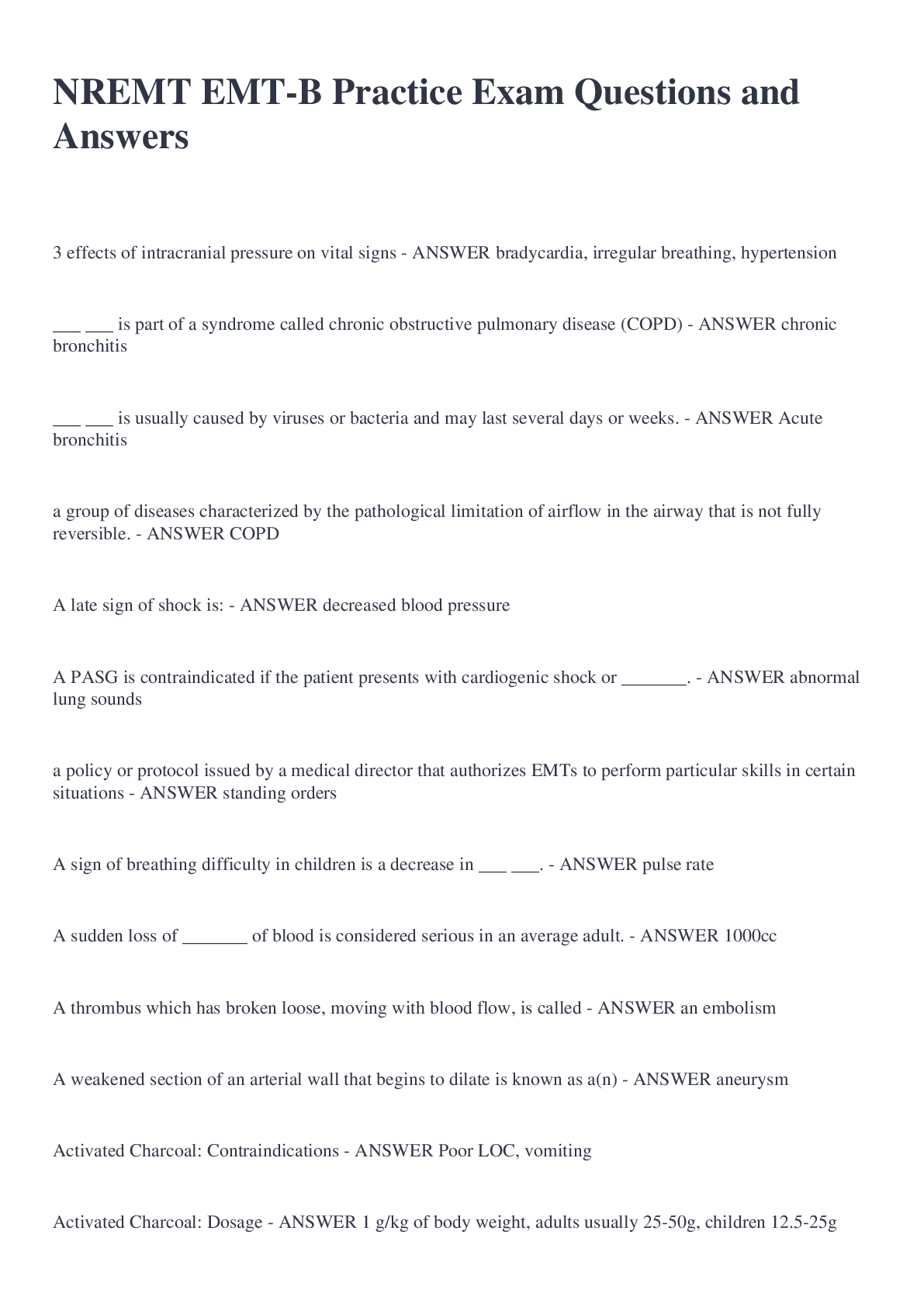
Also available in bundle (2)
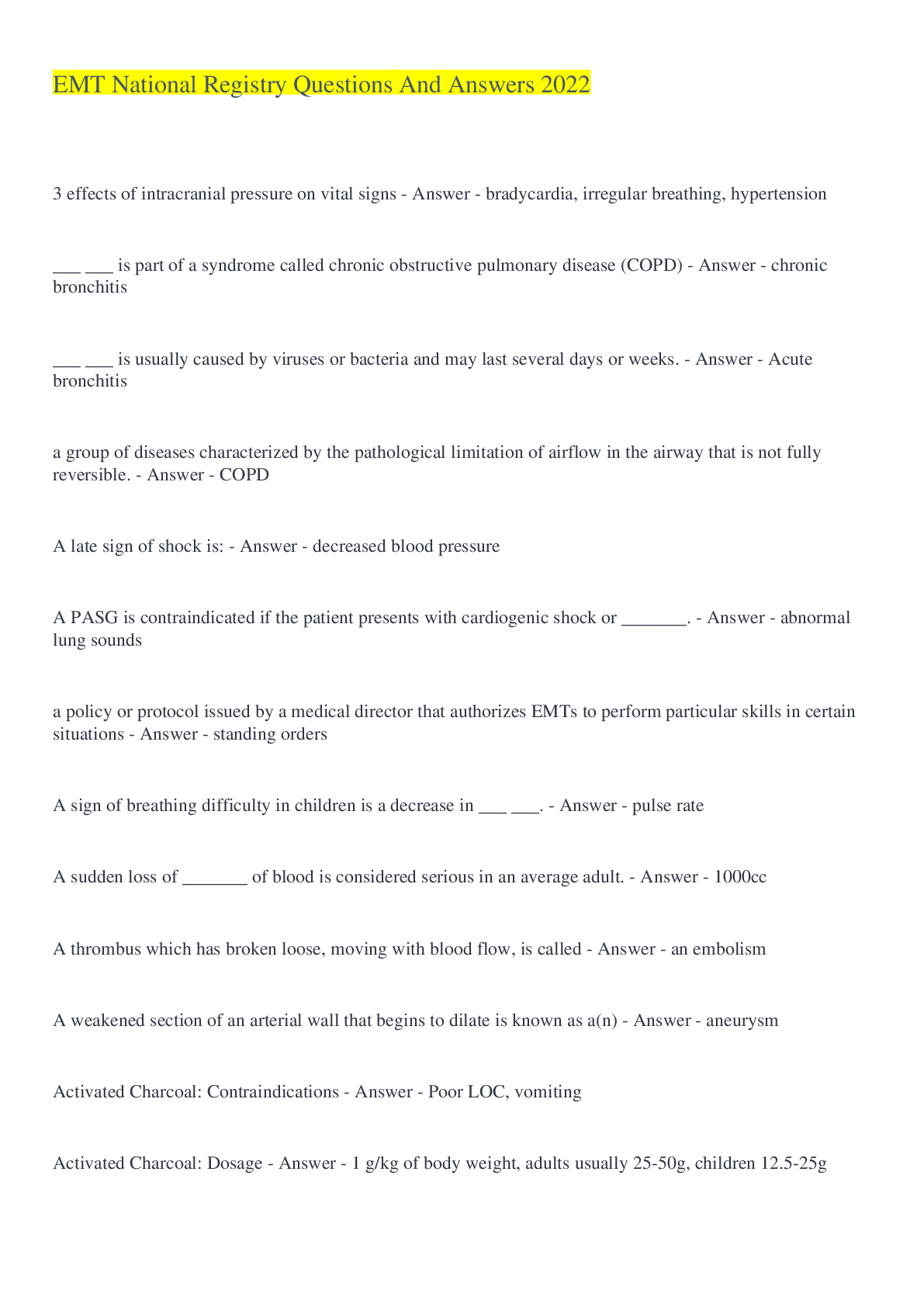
THE EMT BUNDLE, QUESTIONS WITH ACCURATE ANSWERS,
Comprises of all EMT documents, Questions and answers, Graded A+
By bundleHub Solution guider 1 year ago
$50
37

NREMT EXAM BUNDLE. QUESTIONS WITH ACCURATE ANSWERS, LATEST UPDDATES
COMPRISES OF ALL EXAMINABLE NREMT EXAM QUESTIONS WITH ACCURATE ANSWERS.
By bundleHub Solution guider 1 year ago
$32
25
Reviews( 0 )
Document information
Connected school, study & course
About the document
Uploaded On
Aug 12, 2022
Number of pages
63
Written in
Additional information
This document has been written for:
Uploaded
Aug 12, 2022
Downloads
0
Views
82



